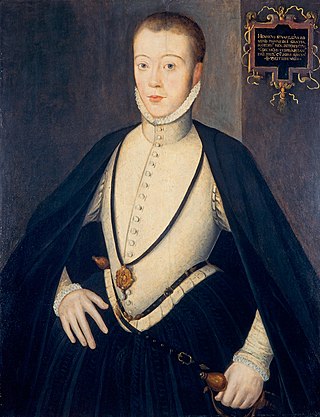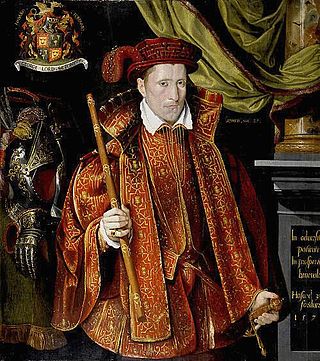Related Research Articles

Henry Stuart, Lord Darnley, was the second husband of Mary, Queen of Scots, and the father of James VI of Scotland and I of England. Through his parents, he had claims to both the Scottish and English thrones, and from his marriage in 1565 he was king consort of Scotland. Less than a year after the birth of his son, Darnley was murdered at Kirk o' Field in 1567. Many contemporary narratives describing his life and death refer to him as simply Lord Darnley, his title as heir apparent to the Earldom of Lennox.

James Hamilton, 3rd Earl of Arran (1537–1609) was a Scottish nobleman and soldier who opposed the French-dominated regency during the Scottish Reformation. He was the eldest son of James Hamilton, Duke of Châtellerault, sometime regent of Scotland. He was of royal descent, and at times was third or fourth in succession to the Scottish crown; several royal marriages were proposed for him, but he eventually never married. He went to France with Mary, Queen of Scots, where he commanded the Scots Guards. After returning to Scotland, he became a leader of the Protestant party against Mary and her French supporters. However, he went insane in 1562 and was confined for the rest of his life.
The Raid of Ruthven, the kidnapping of King James VI of Scotland, was a political conspiracy in Scotland which took place on 23 August 1582. It was composed of several Presbyterian nobles, led by William Ruthven, 1st Earl of Gowrie, who abducted King James VI of Scotland. The nobles intended to reform the government of Scotland and limit the influence of French and pro-Catholic policy, and to prevent or manage the return of Mary, Queen of Scots from England to rule with her son in an "association". Their short-lived rule of around 10 months is known as the "Ruthven" or "Gowrie Regime".

George Home, 1st Earl of Dunbar, KG, PC was, in the last decade of his life, the most prominent and most influential Scotsman in England. His work lay in the King's Household and in the control of the State Affairs of Scotland and he was the King's chief Scottish advisor. With the full backing and trust of King James he travelled regularly from London to Edinburgh via Berwick-upon-Tweed.
Sir John Bellenden of Auchnole and Broughton was, before 1544, Director of Chancery, and was appointed Lord Justice Clerk on 25 June 1547, succeeding his father Thomas Bellenden of Auchnoule. John was knighted before April 1544.
Archibald Douglas, Parson of Douglas, was also Parson of Glasgow, a Senator of the College of Justice, Ambassador to Queen Elizabeth I of England, and a notorious intriguer.
Thomas Randolph (1523–1590) was an English ambassador serving Elizabeth I of England. Most of his professional life he spent in Scotland at the courts of Mary, Queen of Scots, and her son James VI. While in Scotland, he was embroiled in marriage projects and several upheavals. In 1568-1569 he was sent on a special embassy to Russia, visiting the court of Ivan the Terrible.

The Treaty of Berwick was negotiated on 27 February 1560 at Berwick-upon-Tweed. It was an agreement made by the representative of Queen Elizabeth I of England, the Duke of Norfolk, and the group of Scottish nobles known as the Scottish Lords of the Congregation. The purpose was to agree the terms under which an English fleet and army would come to Scotland to expel the French troops who were defending the Regency of Mary of Guise. The Lords were trying both to expel the French and to effect the Scottish Reformation, and this led to rioting and armed conflict.
Sir Henry Killigrew was a Cornish diplomat and an ambassador for the Kingdom of England in the sixteenth century. He was several times employed by Elizabeth I in Scottish affairs and served as one of the English appointees to the Council of State of the Netherlands in the United Provinces in 1586 and 1587–1589. He served as a Member of Parliament for Newport & Launceston in 1553, for Saltash in 1563, and for Truro in 1571–2.

George Seton V, 7th Lord Seton (1531–1586), was a Lord of the Parliament of Scotland, Master of the Household of Mary, Queen of Scots, and Provost of Edinburgh. He was the eldest son of George Seton, 6th Lord Seton, and Elizabeth Hay, a daughter of John Hay, 3rd Lord Hay of Yester. His childhood and schooling were in France.
Claude Nau or Claude Nau de la Boisseliere was a confidential secretary of Mary, Queen of Scots, in England from 1575 to 1586. He was involved in coding Mary's letters with cipher keys.

Thomas Fowler was an English lawyer, diplomat, courtier, spy, servant of the Countess of Lennox, broker of the marriage of Mary, Queen of Scots and Lord Darnley, steward of the Earl of Leicester, advisor to James VI of Scotland and the Scottish ambassador in London, Archibald Douglas.
Sir Roger Aston of Cranford, Middlesex, was an English courtier and favourite of James VI of Scotland.
Robert Melville, 1st Lord Melville was a Scottish diplomat, administrator, jurist, and intriguer, and uncle of the poet Elizabeth Melville.
Sir Anthony or Antony Standen, alias Pompeo Pellegrini, English spy or intelligencer, English Catholic exile. He was recruited by Sir Francis Walsingham and provided critical information about Philip II's preparations of the Spanish Armada.
George Young was a Scottish churchman, courtier, member of the Privy Council of Scotland, diplomat, and secretary depute.
Margaret Fleming, Countess of Atholl (1536-1586) was a Scottish courtier and landowner rumoured to be involved in the occult. She served as lady-in-waiting to Mary, Queen of Scots.
Andrew Melville of Garvock was a Scottish courtier and servant of Mary, Queen of Scots.

Cuthbert Rayne or Reyne or Raine was an English huntsman who served James VI of Scotland. James VI employed several English hunters and kennelmen who organised his field sports and looked after his dogs, including "Robert the English hunter", Cuthbert Armourer, Edward Dodsworth, and Cuthbert Rayne. In 1582, new kennels were built at Holyrood Palace for dogs brought to James by an English huntsman, Nicholas Poorhouse. English aristocrats wishing to court the king's favour sent dogs, in 1585 Philip Sidney sent a "lyme hound".
Charles de Prunelé, Baron d'Esneval was a French diplomat and ambassador in Scotland in 1586. The Château d'Esneval is at Pavilly, Seine-Maritime. He is known by his title, as "D'Esneval", or "D'Aisneval", or "D'Anneval".
References
- ↑ John Strype, Annals of the Reformation, vol. 3 part 1 (Oxford, 1824), p. 567: John Bruce, Leycester Correspondence (London: Camden Society, 1844), p. 345.
- ↑ Sophie Crawford Lomax, Calendar State Papers Foreign Elizabeth, 20 (London, 1921), p. 352.
- ↑ Calendar State Papers Scotland, vol. 8 (London, 1914), pp. 536-7.
- ↑ Calendar State Papers Scotland, vol.8 (London, 1914), pp.501-507, 534: Rymer, Thomas, ed., Foedera, vol. 15, p. 805.